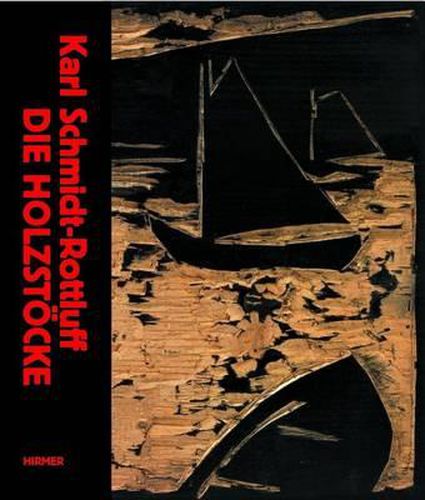Readings Newsletter
Become a Readings Member to make your shopping experience even easier.
Sign in or sign up for free!
You’re not far away from qualifying for FREE standard shipping within Australia
You’ve qualified for FREE standard shipping within Australia
The cart is loading…






English summary: Wood blocks reveal unmediated the creative formation of the wood cuts: they document the process and the involvement of the artist with the material more than the flat impression made on paper. Besides the graphics, the particular affinity of Karl Schmidt-Rottluff for the material of wood is revealed in the production of sculptures, furnishings, and handcrafts. The graphic formation of the wood blocks stands on the cusp for three-dimensional works. With over 200 wood blocks, the Bruecke-Museum possesses almost half of Schmidt-Rottluff’s wood works, which were donated by the artist himself in 1975. The wood-block collection contains the early small-formal works from around 1905 up to the later 1920’s and provides an extensive survey of Schmidt-Rottluff’s work, among which are advertising works, ex libris prints, periodical and map letterhead. From the middle of the 1920’s the artist experimented with the technique of color wood cuts: he used multiple discs, cut the blocks for print with different colors or colored a block with multiple colors. The catalog presents the wood blocks in full-page color tables across from the corresponding graphic pages from the collection of the museum. The accompanying texts address the process, the specific quality of expression and the creative process of the technique. German description: Die Holzstoecke offenbaren unmittelbar die schoepferische Genese der Holzschnitte, mehr als der flachige Druck auf Papier dokumentieren sie die Bearbeitung und die Auseinandersetzung des Kuenstlers mit dem Material. Neben der Graphik zeigt sich die besondere Affinitat Karl Schmidt-Rottluffs fuer den Werkstoff Holz in der Anfertigung von Skulpturen, Moebeln und Kunsthandwerk. Die plastische Gestaltung der Holzstoecke steht an der Schwelle zum dreidimensionalen Schaffen des Kuenstlers. Das Bruecke-Museum besitzt mit ueber 200 Holzstoecken fast die Halfte des Holzschnittwerkes Schmidt-Rottluffs - der Kuenstler selbst hatte sie 1975 dem Museum geschenkt. Die Holzstock-Sammlung reicht von fruehen kleinformatigen Arbeiten um 1905 bis in die spaten zwanziger Jahre und gibt einen umfassenden UEberblick ueber das Werk Karl Schmidt-Rottluffs, darunter auch gebrauchsgraphische Arbeiten wie Ex libris, Zeitschriften- und Mappentitel. Ab Mitte der zwanziger Jahre experimentierte der Kuenstler mit der Technik des Farbholzschnitts: Er verwendete mehrere Platten, zersagte die Stoecke fuer den Druck mit verschiedenen Farben oder farbte einen Stock mit mehreren Farben ein. Der Katalog prasentiert die Holzstoecke auf ganzseitigen Farbtafeln und stellt die entsprechenden graphischen Blatter aus der Sammlung des Museums gegenueber. Die begleitenden Texte thematisieren die Bearbeitung, die spezifische Ausdrucksqualitat und den Schaffensprozess der Technik.
$9.00 standard shipping within Australia
FREE standard shipping within Australia for orders over $100.00
Express & International shipping calculated at checkout
English summary: Wood blocks reveal unmediated the creative formation of the wood cuts: they document the process and the involvement of the artist with the material more than the flat impression made on paper. Besides the graphics, the particular affinity of Karl Schmidt-Rottluff for the material of wood is revealed in the production of sculptures, furnishings, and handcrafts. The graphic formation of the wood blocks stands on the cusp for three-dimensional works. With over 200 wood blocks, the Bruecke-Museum possesses almost half of Schmidt-Rottluff’s wood works, which were donated by the artist himself in 1975. The wood-block collection contains the early small-formal works from around 1905 up to the later 1920’s and provides an extensive survey of Schmidt-Rottluff’s work, among which are advertising works, ex libris prints, periodical and map letterhead. From the middle of the 1920’s the artist experimented with the technique of color wood cuts: he used multiple discs, cut the blocks for print with different colors or colored a block with multiple colors. The catalog presents the wood blocks in full-page color tables across from the corresponding graphic pages from the collection of the museum. The accompanying texts address the process, the specific quality of expression and the creative process of the technique. German description: Die Holzstoecke offenbaren unmittelbar die schoepferische Genese der Holzschnitte, mehr als der flachige Druck auf Papier dokumentieren sie die Bearbeitung und die Auseinandersetzung des Kuenstlers mit dem Material. Neben der Graphik zeigt sich die besondere Affinitat Karl Schmidt-Rottluffs fuer den Werkstoff Holz in der Anfertigung von Skulpturen, Moebeln und Kunsthandwerk. Die plastische Gestaltung der Holzstoecke steht an der Schwelle zum dreidimensionalen Schaffen des Kuenstlers. Das Bruecke-Museum besitzt mit ueber 200 Holzstoecken fast die Halfte des Holzschnittwerkes Schmidt-Rottluffs - der Kuenstler selbst hatte sie 1975 dem Museum geschenkt. Die Holzstock-Sammlung reicht von fruehen kleinformatigen Arbeiten um 1905 bis in die spaten zwanziger Jahre und gibt einen umfassenden UEberblick ueber das Werk Karl Schmidt-Rottluffs, darunter auch gebrauchsgraphische Arbeiten wie Ex libris, Zeitschriften- und Mappentitel. Ab Mitte der zwanziger Jahre experimentierte der Kuenstler mit der Technik des Farbholzschnitts: Er verwendete mehrere Platten, zersagte die Stoecke fuer den Druck mit verschiedenen Farben oder farbte einen Stock mit mehreren Farben ein. Der Katalog prasentiert die Holzstoecke auf ganzseitigen Farbtafeln und stellt die entsprechenden graphischen Blatter aus der Sammlung des Museums gegenueber. Die begleitenden Texte thematisieren die Bearbeitung, die spezifische Ausdrucksqualitat und den Schaffensprozess der Technik.